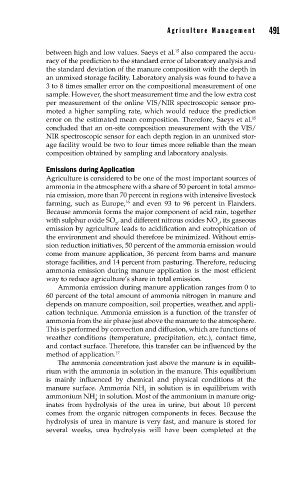Page 519 - Biosystems Engineering
P. 519
Agricultur e Management 491
15
between high and low values. Saeys et al. also compared the accu-
racy of the prediction to the standard error of laboratory analysis and
the standard deviation of the manure composition with the depth in
an unmixed storage facility. Laboratory analysis was found to have a
3 to 8 times smaller error on the compositional measurement of one
sample. However, the short measurement time and the low extra cost
per measurement of the online VIS/NIR spectroscopic sensor pro-
moted a higher sampling rate, which would reduce the prediction
15
error on the estimated mean composition. Therefore, Saeys et al.
concluded that an on-site composition measurement with the VIS/
NIR spectroscopic sensor for each depth region in an unmixed stor-
age facility would be two to four times more reliable than the mean
composition obtained by sampling and laboratory analysis.
Emissions during Application
Agriculture is considered to be one of the most important sources of
ammonia in the atmosphere with a share of 50 percent in total ammo-
nia emission, more than 70 percent in regions with intensive livestock
16
farming, such as Europe, and even 93 to 96 percent in Flanders.
Because ammonia forms the major component of acid rain, together
with sulphur oxide SO , and different nitrous oxides NO , its gaseous
2 x
emission by agriculture leads to acidification and eutrophication of
the environment and should therefore be minimized. Without emis-
sion reduction initiatives, 50 percent of the ammonia emission would
come from manure application, 36 percent from barns and manure
storage facilities, and 14 percent from pasturing. Therefore, reducing
ammonia emission during manure application is the most efficient
way to reduce agriculture’s share in total emission.
Ammonia emission during manure application ranges from 0 to
60 percent of the total amount of ammonia nitrogen in manure and
depends on manure composition, soil properties, weather, and appli-
cation technique. Ammonia emission is a function of the transfer of
ammonia from the air phase just above the manure to the atmosphere.
This is performed by convection and diffusion, which are functions of
weather conditions (temperature, precipitation, etc.), contact time,
and contact surface. Therefore, this transfer can be influenced by the
method of application. 17
The ammonia concentration just above the manure is in equilib-
rium with the ammonia in solution in the manure. This equilibrium
is mainly influenced by chemical and physical conditions at the
manure surface. Ammonia NH in solution is in equilibrium with
3
ammonium NH in solution. Most of the ammonium in manure orig-
+
4
inates from hydrolysis of the urea in urine, but about 10 percent
comes from the organic nitrogen components in feces. Because the
hydrolysis of urea in manure is very fast, and manure is stored for
several weeks, urea hydrolysis will have been completed at the

